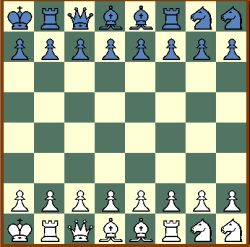King to Bunker Leap!
Introduction
The Fischer Random variant of shuffle chess is rapidly becoming the chess of the new millennium.
The player can castle by transposing the king and rook from any of their possible initial squares to the usual post-castle positions of standard chess.
This transformation from a chaotic start position to a more familiar middle game is one of the greatest appeals of Fischer Random.
King to Bunker Leap is a new "king safety" rule devised to make the remaining 1920 (2880 -960) possible start positions more appealing to chess players.
This new rule can be applied to both Shuffle chess and to the very interesting Pre-chess (Pal Benko's Pre-Chess) - a game in which each side sets up their own pieces in the back rank.
Basically it boils down to this: During the course of play, either side can move the king from the original square to the b or g file jumping over any friendly pieces if necessary. This move can be carried out only once, takes a turn and is subject to similar restriction as in castling. The only difference is that the rook is not involved and the king can actually jump.The king relocation is in many ways extreme, but still quite a logical extension of the chess960 castling rules. It bears some resemblance to the older king's leap move described much earlier during the evolution of chess.
If one can get past the initial strangeness of a king jumping from one wing to another - something that can happen using chess960 castling rules as well - then an entire new dimension of attack and defensive strategy is opened up.
Rules
There are at least two game systems that can be used with these new rules- Shuffle Chess (Symmetrical ) - Like Fischer Random the start position is determined randomly, but unlike FRC, the king does not have to be between two rooks.
- Pre-chess (symmetrical/asymmetrical depending on players). Here each side beginning with white alternately setup each of their pieces one at a time on the back rank. The bishops must be set on opposite color, and there are no restrictions on king and rooks.
The mechanism for castling is similar to FRC with the exception that there is no long/short castling; a-side castling results in king on b file and rook on c file; h-side castling is same as in FRC king on g file rook on f file.
Castling is permitted for following start positions:
Any start position where king is between rooks.
In positions where both rooks are to the left or right of king, castling is permitted only with the rook further away from it. (The rook in between must be moved.)
The restrictions for castling or king to bunker leap are similar:
- King must be unmoved for it to bunker leap. For castling, the corresponding rook must also be unmoved.
- Cannot castle or bunker leap out of check.
- King cannot pass over or land on attacked squares.
- For castling there must be a clear path between the king and castling rook (as in FRC). For king to bunker leap, there must not be any enemy pieces in between. It can jump over its own pieces.
King to Bunker Leap Examples
 |
 |
 |
|
Here king can stay in a file or jump to g file or castle with rook on the f file.
In this position, only h-side castling with the f rook is permitted. |
Here white king has jumped to g file.
Note that in this case, if the b rook was moved off the back rank first, then Casting and King to Bunker Leap would result in identical positions. |
|
 |
 |
|
|
Here king can stay castle with h rook only after moving g rook. But it can leap to b file quite easily.
In this start position, only h side castling with the h rook is permitted. King to Bunker leap is permitted for both sides in all possible positions. |
The white king has jumped to the b file,
while black has castled with the h rook after moving the g rook. White's pieces seem to be developed a bit better. Note this is just a sample game. |
|
Play the Game!
Play King to Bunker Leap! (Free Registration at chessvariants.org required).View Game Logs for King to Bunker Leap
 Download Zillions of Games File
Download Zillions of Games File
Other notes
I created this while I was messing around with programming shuffle chess/pre chess into zillions and realizing that there was no castling for many of the non-standard positions.
The King to Bunker Leap gives a player a bit more flexibility allowing the king to jump to safety even after moving the rooks or without moving the pieces in between. It is very useful in some of the awkward shuffle chess start positions where the many pieces need to be moved off or those in which two rooks are on one side of the king making it impossible to castle on the other side.There have been quite a few alternate proposals for castling in shuffle chess. Once such method: slide shuffle suggests that a piece other than a rook is used to castle. However, this makes development of the "castling" piece more difficult and there would be times when players will be castling to the center: a not very desirable and strange artifact of this rule. In Transcendental Chess simply transposing any two pieces in the first move is allowed. Again depending on the setup, this may not allow the pieces to develop quickly. In contrast, the king to bunker leap specifically sets the destination square like the standard FRC castling except that the actual move is done with the king alone. And used in conjunction with the modified FRC castling, it seems more logical to visualize it as a king's leap to the bunker, or a joint move to centralize the rook and get to the bunker position.
further thoughts
This variant ends my excursion into variants for good. Exploring chess variants is a fun pastime but it seems like a better time could be had simply by playing and trying to improve at standard chess. It may sound like heresy for others here, but I have made a complete 360 degree turn.Even though playing chess variants that rekindled my passion for chess, I find that playing many variants actually limits your scope for understanding chess in the long run. Despite their bewildering variety they are merely empty desolate worlds devoid of all light and barely lit by the occasional soul who plays them. The variant player constantly delights in new pieces and this by itself is quite an intriguing pursuit, but not at the cost of failing to see the possibilities of the existing pieces.
Fischer Random or even Shuffle/Pre Chess as described here still keep the same pieces and only differ in terms of setup and castling. The tactics and strategy remain almost the same and so preserve the original game. If it is variety one wants, then Fischer Random and/or the other forms of Shuffle Chess are more than sufficient to supplement orthodox chess.Historical Relevance
Shuffle Chess was proposed many times during the rich history of chess.In 1978, Pal Benko proppsed the new chess variant: Pre-Chess.
In June 1996, former World Chess champion Bobby Fischer announced the rules of Fischer Random Castling in Argentina.
In 2009, Charles Daniel invented King to Bunker Leap for the first time with these exact specifications.
|
If you would like to email the chess variant inventor directly: inventor@chess.computerwebservices.net
|
|
Posted by: Chesster on 2009-10-23 14:27:16 Like Chess: YES
I like this very much. This and Fischer Random should be implemented in chess engines. |

